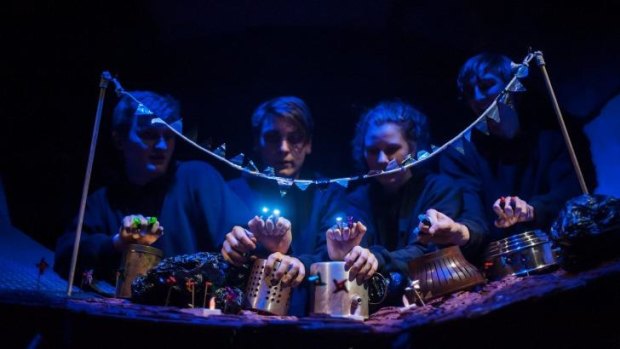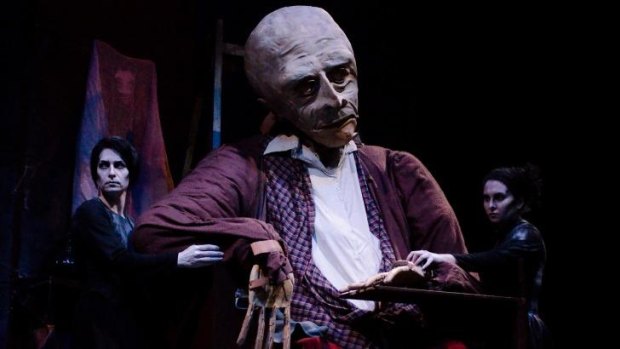This was published 8 years ago
The Dead Puppet Society: All hands on deck in a puppet show with no strings attached
By Liza Power
When the duo behind Dead Puppet Society began work on their sixth production, they decided to try a novel approach: a puppet show without puppets. Their previous show, The Harbinger, had featured a giant puppet called Old Man and hundreds of props; not a day went by that extensive repairs weren't required. So they went to the other extreme, developing a small-scale show with no fixed objects.
"What that leaves you with is hands," says artistic director David Morton from New York, where he and executive producer Nicholas Paine are in residence at the New Victory Theatre. And so Argus, a tiny character who embarks on a great adventure, assumed the shape of eight puppeteers clasping their hands together.
"This little figure emerged and the thing we fell in love with is that because he's made of hands he has no physical form. So he can disappear and appear at will," Morton says. "We ended up thinking that made him quite fragile and vulnerable because he has to work constantly to keep himself together. We imagined this little creature building a home with creatures like himself, and the adventure he would go on if he lost that family and had to try and find them again."
The resulting production, developed with Handspring Theatre Company (who brought us War Horse) in South Africa, premiered at Brisbane Powerhouse in 2013. Next month, after productions around Australia and in New York, it comes to ArtPlay at Birrarung Marr. Loosely inspired by The Odyssey and The Iliad, it is, Morton says, "an epic quest told on a minute scale": Argus is 20 centimetres tall and his stage measures 50 centimetres by 1.2 metres. In a realm forged from household objects such as colanders, garden pots, torches and water bottles, its creators call it "pure imaginative play". Accompanied by an original score by John Babbage and performed by the Topology ensemble, it's a tiny tale that needs 10 people (four puppeteers, four musicians and two technicians) to tell it.

Samuel Whatley, left, Benjamin Newth, Laura Hague and Liam Howarth perform Dead Puppet Society's Argus.Credit: Dylan Evans
Dead Puppet Society is based in Brisbane; the company took shape when its founders were in the final year of theatre degrees at Queensland University of Technology. What started as a conversation over a kitchen table six years ago has grown into a company that has created nine shows and had residencies with Queensland Theatre Company, the New Victory Theatre in New York and St Anne's Warehouse in Brooklyn.
Morton and Paine also spent time in South Africa working with Handspring after an unlikely introduction. Morton had been studying the company for his PhD, but after numerous attempts to make contact had given up. One weekend, Paine's father read Morton's thesis and recognised the name of the company's founder, Adrian Kohler, as his boyhood neighbour in South Africa. During a three-hour phone call, Kohler offered to mentor the youngsters. The pair applied for an Australia Council Jump mentorship grant and bought plane tickets.
Their timing was impeccable, Paine says. "They were coming to the end of their fabrication for War Horse, an eight-year journey for them, and we got to see the conclusion of that. We were working on Argus at the time, so we asked a lot of questions about putting together the show." Kohler schooled them on the importance of diversifying their practice and creating markets for their work overseas; they began looking to the US and the opportunities it afforded to develop new work and present it on a larger scale. "We didn't want to leave Australia," Morton says, "because we want to continue creating work there. So we're trying to keep moving between."
Watch Argus and the first thing that will strike you is the physicality of its puppeteers. All four must move as one; if they don't their little character's ribcage will collapse, his head will fall off or his feet will give way. In rehearsals, the performers had to maintain this unison for seven-hour stints, mastering the concord required to keep a hand-made man in shape.

The giant puppet from The Harbinger.
"When we spent time with Handspring, they constantly compared [this kind of performance] to ballerinas on pointe. It's a strenuous art form and the performers are like dancers in a choreographic work," Paine says.
While Argus is ostensibly a show for children, the duo's larger focus is on puppetry for grown-ups. Morton's PhD focused on storytelling methodology and devices for adult theatre. "It was a bit of a manifesto for the company, really. For us, puppetry is to theatre what digital animation is to film; it expands the storytelling possibilities."
Paine adds: "There are things you can do with puppets that are either very expensive or illegal to do with people. You can play with different scales, and quite literally invent what characters look like from the ground up."
The pair are developing Laser Beak Man, a production based on the illustrations of Australian artist and autism advocate Tim Sharp. The three met in 2013 when Argus was premiering at Brisbane Powerhouse and Sharp's work was being exhibited in the foyer. Sharp's wit and penchant for visual puns proved irresistible. Says Morton: "Laser Beak Man is a superhero who lives in Power City. His superpower is that he has a laser in his beak and when he shoots it he turns bad things into good things, solving crime and keeping the world safe."
Paine adds: "Our favourite illustration depicts a line of Barbies waiting at a grill to get sausages, it's called the Barbie Queue. He has this beautiful, literal sense of humour."
The show uses 60 of Sharp's illustrations and will premiere in Australia and New York next year. Another work, Wider Earth, has been commissioned by Queensland Theatre Company.
Morton says there's a "nice energy" that comes from the projects having lives and ownership across the two countries. "People become interested in projects because they're happening somewhere else. And the productions take on multiple lives."
While relishing their time in the US, they say Australia is a special place to create work: "There's definitely a really cool Australian sensibility," Morton says.
"Over here, companies don't make use of puppets within theatre. It's a divided industry; either you work in theatre or in puppetry. At home those boundaries are blurred and Australian artists are far more playful with the form."
Paine adds: "Over here, people don't list their training on their resume, they list who they've been trained by; it's a cultish mentality: 'I know this person's method so my job is to replicate that method'. In Australia, it's much more a culture of begging, borrowing, stealing, making your own."
If the two are even a tad intimidated by the vibrancy and dynamism of New York's performance scene, they're not saying it. "We're pretty confident of carving out a niche for ourselves here," Paine says. Morton thinks puppetry is undergoing a renaissance thanks to the success of War Horse and directors such as Julie Taymor (who staged the Broadway version of The Lion King). "There's definitely a piqued interest for adult puppet shows now," he laughs. "Which is good, because we really like making these dark and kooky tales."
Argus is at ArtPlay July 8-9.